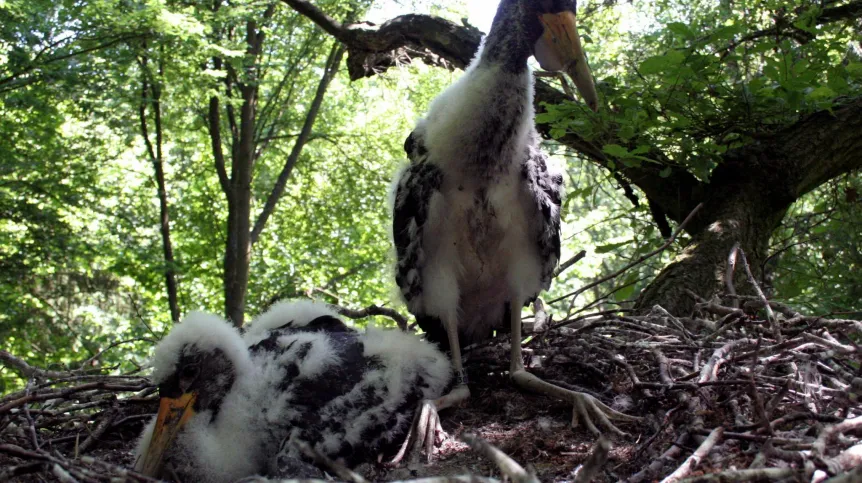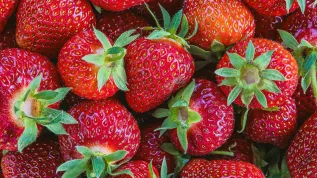
You can watch the life of a black stork family with two chicks thanks to the pioneering online broadcast from their nest in the Regional Directorate of State Forests in Łódź. The broadcast from another nest showed that storks also have natural enemies - three chicks were taken by a hawk.
Black Stork is covered by strict protection in Poland and the number of these birds is currently estimated at 1400-1600 pairs. The exact locations of their nests are kept secret to protect the birds from intruders. Developing chicks born in May and behaviour of two adult storks can be watched through online broadcast at: lodz.lasy.gov.pl/bocianyczarne
Spokeswoman of Regional Directorate of State Forests in Łódź, Hanna Bednarek-Kolasińska emphasized that this project, pioneering in Poland and one of the few of its kind in Europe, has scientific and educational purposes, and observations will bring a lot of valuable information for ornithologists and scientists who are particularly interested in the black stork species.
"This project has a very important role in Poland, because it is a pioneering project. In Poland, this is the only place where we observe black storks nest. As a result, scientists gain a lot of knowledge about the biology of this species, and people who simply like the stork family can watch the birds\' life in the nest" - Bednarek-Kolasińska told PAP.
This year Łódź foresters and ornithologists region selected two permanent nesting sites of black storks. At each nest at a height of several meters they installed a camera with infrared function.
From one of the observed nests on an oak a hawk snatched three chicks while the adult birds were feeding. It was a surprise, because in central Poland so far only marten attacks on the black stork chicks have been observed.
"This broadcast has shown that the black stork has enemies, but we did not expect a hawk, which generally weighs as much as the chicks (approx. 1 kg), could take them from the nest. Hawk did that because it wanted to feed its young. As the hawk, like the black stork, is a protected species, we could not do anything about it. We could watch as the hawk systematically took the young storks from their nest. It was horrible and the people who were watching commented on the situation, they were terrified, together with us they experienced this tragedy in the stork\'s nest" - reported the spokeswoman.
In the nest slot on a pine two chicks have hatched - now they are older, weigh more than 3 kg and are not in such danger. Thanks to the broadcast we can watch as they prepare for the first flight. "We see that they begin jumping up and down, lift their legs from the nest, which means they are training for flying, they spread wings, and we see that this sometimes bothers another chick, we watch them eat - everything that happens in the nest is incredibly interesting" - said Bednarek-Kolasińska.
Adult birds only brig food and watch their offspring from the neighbouring branches. Acquiring food for the chicks, mainly fish - eel and Prussian carp, however, is difficult because of the drought, and a nestling can swallow a dozen of such fish in one feeding.
Black stork\'s nest is over 1 m in diameter and can weigh more than a ton. Both birds sit on eggs, but the male\'s part is smaller and at night only the female incubates. Black stork chicks after hatching are covered with delicate white fluff, and only after the development of feathers they gain black and white plumage. With time the colour of their beak also changes - is initially yellow, later yellow-green, and only in winter it becomes red.
Both chicks will probably start flying out of the nest in early August. In order to keep them in sight, the researchers fitted them with small, solar powered GPS/GSM locators.
"Locators will allow us to observe them after they leave the nest and fly to the wintering grounds in Africa. These observations are unique in our country, because until now these birds have not been fitted with recorders that run on solar power and send text messages with coordinates, which can be located on the map. We will see how the stork flies" - added the spokeswoman.
Scientists are curious whether, for example, the siblings will stick together after leaving the nest, fly to Africa together, and where they will spend the winter. Black storks during each season are monogamous birds. In subsequent seasons partners can change. Each pair builds usually more than one nest, they can be located a few kilometres away from each other and inhabited in subsequent years.
Bednarek-Kolasińska emphasised that this species, unlike its cousin, the white stork, prefers solitude and stays away from people. Young storks and their parents face a very difficult journey in autumn. In the south of Europe people still shoot migrating birds, in Turkey and Lebanon shooting them is the national pastime, and in Egypt people catch them in nets and eat them. Most black storks from Poland flying to Africa choose the eastern route - through the Bosphorus/Dardanelles and have to fly more than 7000 km; only some choose a shorter route via Gibraltar.
The online broadcast from the black stork\'s nest is a joint project of the Regional Directorate of State Forests in Łódź and the Eagle Protection Committee. "This project will bring many interesting observations, help researchers study this species, its breeding season, the storks\' behaviour, their habits, how to spend the winter. But it will also be interesting to watch for people who like this family, watch the storks and comment on the things happening in the nest"- noted the spokeswoman.
Black Stork (Ciconia nigra) inhabits a huge area from the Iberian Peninsula to the eastern coast of Russia and China. European black storks winter in Africa, south of the Sahara. Even in the late nineteenth and early twentieth century there were very few black storks in Poland. In 1966 the total number was estimated at 500 - 530 breeding pairs. Thanks to their protection, the efforts of foresters, scientists and nature lovers the species was preserved and has adequate living conditions, which resulted in an increase in the number of pairs to 1600.
90 percent of the population inhabits lowland and upland areas, and the remainder the Carpathians and the Sudetes. The species is under strict protection and foresters set protection zones around occupied nests of black storks.
About 1,000 foresters throughout the country are involved in the program for the protection and monitoring of the population of the species.
PAP - Science and Scholarship in Poland
szu/ luo/ hgt/
tr. RL













